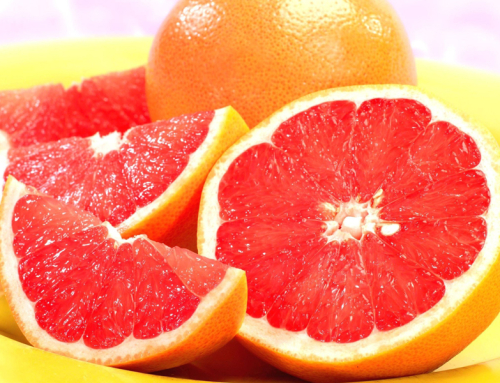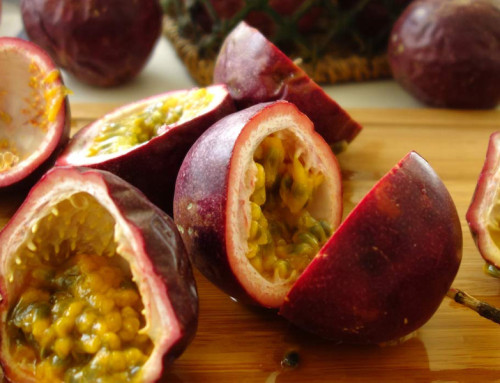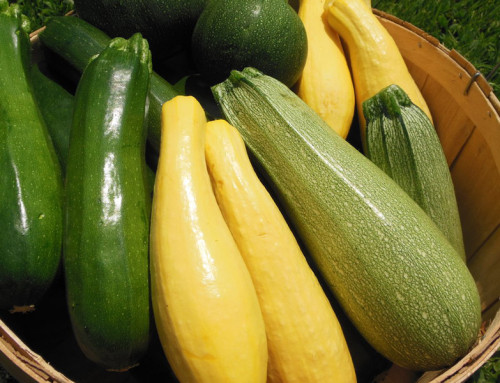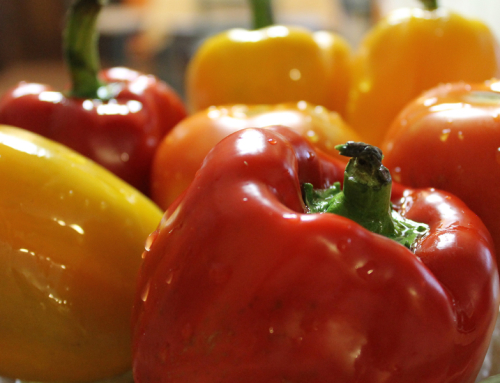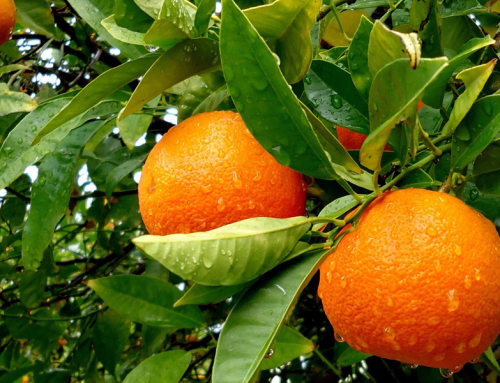- Whole Tomato, medium, 2 3/5″ in diameter or 123 g – 26 calories
- Cherry Tomato, 17g – 4 calories
- Tomatillos, medium or 34g – 11 calories
- Raw Tomato, Chopped or Sliced, 1 cup or 180g – 38 calories
- Tomato Slice, medium, 1/4″ thick or 20g – 4 calories
- Canned Tomato, 1 cup or 240g – 46 calories
- Tomato Sun Dried, plain, 1 piece or 2g – 5 calories
- Tomato Sun Dried, in oil, 1 piece or 3g – 6 calories
- Tomato Juice, canned with salt, 1 cup or 243g – 41 calories
- Tomato Sauce, canned, 1 cup or245g – 74 calories
For sun-dried tomatoes and tomatillos, the drying process increases the sugar concentration by decreasing the water content, but the calories remain the same. For canned and stewed tomatos, read the nutrition label on the can.
Tomatoes
The tomato is a savory fruit, not a vegetable, because it carries its own seeds with it. However it has some incredible phyto-chemical properties and even more health benefits than in an apple.
- Tomatoes are excellent sources of antioxidants, dietary fiber, minerals, and vitamins despite their low caloric content. They are often recommended for inclusion in cholesterol control diets and weight loss programs.
- Tomatoes provide 21% of the RDA for vitamin C per 100 g serving. This antioxidant is important for immune system functioning, developing resistance against infection, and scavenging harmful free radicals.
- Tomatoes contain moderate levels of B-complex vitamins such as folate, thiamin, niacin, riboflavin.
- Tomatoes contain flavoniod antioxidants such as alpha-carotenes and beta-carotenes, xanthins and lutein, as well as having good levels of vitamin A. These are pigment-related compounds that help maintain healthy vision, mucus membranes, skin, and bone health. Fruits rich in flavonoids are known to give protection against lung and oral cavity cancers. The carotenoids can protect cells from harmful free radicals.
- Tomatoes contain lycopene, a unique flavonoid antioxidant phytochemical that is more concentrated in the red varieties. Lycopene protects the skin from damage by ultra-violet (UV) rays and may protect against skin cancer.
- Zea-xanthin is another abundant flavonoid compound that helps protect eyes from age-related macular disease (ARMD) by filtering harmful ultra-violet rays.
- Other antioxidants have been found to protect against additional cancers, including colon, prostate, breast, endometrial, lung, and pancreatic tumors. Total -ORAC (Oxygen Radical Absorbance Capacity) in this vegetable is 367 µmol TE/100 g.
- Fresh tomatoes are very rich in potassium with 237 mg per 100 g serving. Potassium is essential in regulating cell and body fluids that help control heart rate and blood pressure.
- Tomatoes have just 5 mg of sodium which is important in balancing fluids with potassium.
- Tomatoes contain the essential minerals of iron, calcium, manganese and other trace elements.
Tomatillo Berries
- Tomatillo berries contain slightly more calories, fat, and protein than tomatoes, but have relatively good amounts of dietary fiber, minerals, anti-oxidants and vitamins.
- The tomatillo has more minerals per weight than tomatoes do and contain copper, iron, phosphorous, manganese, and other trace minerals.
- A fresh tomatillo has a very good sodium to the potassium ratio (0:6)
- The tomatillo does not contain lycopene, like the tomato does.
- Tomatillo berries are rich in the phytochemical antioxidants known as withanolides. Ixocarpalactone-A is one that has been found to have anti-bacterial and anti-cancer properties.
- A tomatillo contains small amounts of the antioxidant vitamins A, C, and E. Vitamin A is required for maintaining healthy mucus membranes and skin and vitamin C is important for immune system health.
- Tomato berries contain flavoniod antioxidants such as beta-carotene, zea-xanthin and lutein, as well as a small amount of vitamin A. These are pigment-related compounds that help maintain healthy vision, mucus membranes, skin, and bone health. Fruits rich in flavonoids are known to give protection against lung and oral cavity cancers. The carotenoids can protect cells from harmful free radicals.
Tomatoes
Tomatoes (Lycopersicon esculentum) are members of the Solanaceae or nightshade family of common vegetables of which potatoes, chili peppers and eggplants, among others, are also members. Originally thought to be poisonous due to the bright red “warning” color, this fruit was cultivated by the Aztecs centuries before the Spanish explorers arrived and introduced it to the world.
If you run across any purple tomatoes in the future, these are genetically engineered designer tomatoes and are filled with antioxidants known as anthocyanins which are commonly found in dark berries such as blackberries and black currants. Scientists used genes from a snapdragon flower, which is where the purple color came from but “human trials” are considered to be far off, and that actually may be a good thing due to them being GMO’s and who knows what lurks in something that was not naturally produced by normal mutation or adaptation.
Cherry Tomatoes
Cherry tomatoes (Solanum lycopersicum var. cerasiforme) are rather small, about an inch in diameter, or “cherry-sized”, and are usually round and red, although there are some pear-shaped varieties, as well as yellow cherries and they tend to be most popular in the Mediterranean areas.
Heirloom Tomatoes
Heirloom tomatoes are open-pollinated varieties that were introduced prior to 1940, or are than 50 years old or have been passed down through families for several generations. These are becoming more popular among organic gardeners because they are more flavorful and natural then the hybrid varieties.
Tomatillo
The tomatillo, Physalis philadelphica (Physalis ixocarpa) is berry that is known by many common names: tomate tomate verde, miltomate, tomate, tomate de cascara, husk tomato, tomate de fresadilla and others that may incorporate parts of the scientific name. It is a small round berry in the tomato family that is used as a vegetable, although it is actually fruit due to carrying its own tiny seeds. It also was cultivated by the Aztecs. It has a tart, yet sweet quality and is a common ingredient in Central American style sauces.
Unlike tomatoes, tomatillo berries develop inside a thin, semi-transparent calyx or husk that resembles a Japanese paper lantern. When the berry has matured, the paper calyx splits and a green berry is seen. The average tomatillo is about an inch in diameter and weighs approximately 50 g with a juicy pulp.
Tomatillo berries only need to have the husk and stem removed. They do not need to be peeled any further. They do have a bit of a sticky film-like residue under the husk, so rinse them throughly until it is gone.
That being said, people often peel tomatoes, but they are removing a lot of the health benefits by doing so since a peeled tomato will have less calories, less fiber and less vitamins. Commercial tomato skin may or may not have pesticides on it and they may or may not be sprayed with a food grade wax (usually carnauba) to make them look shiny in the store, and to preserve moisture. But the skin was meant to be eaten with the tomato and washing your fruit before eating is always a good idea. Wiping them with vinegar removes the wax, so these issues are alleviated. Buying organic tomatoes solves both issues completely, so eat the skin.
Note: Tomatoes and tomatillo berries can sometimes produce an allergic reaction with symptoms such as itching eyes, runny nose, or gastrointestinal disturbances such as abdominal pain, vomiting and diarrhea. Cross-reactions with other members of the nightshade family, such as eggplant, potato and chili peppers, may also occur.


